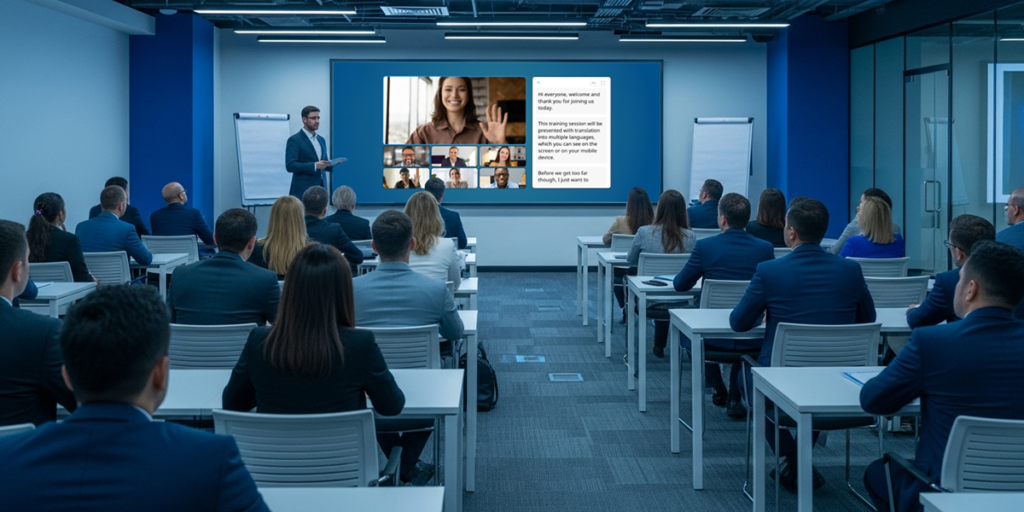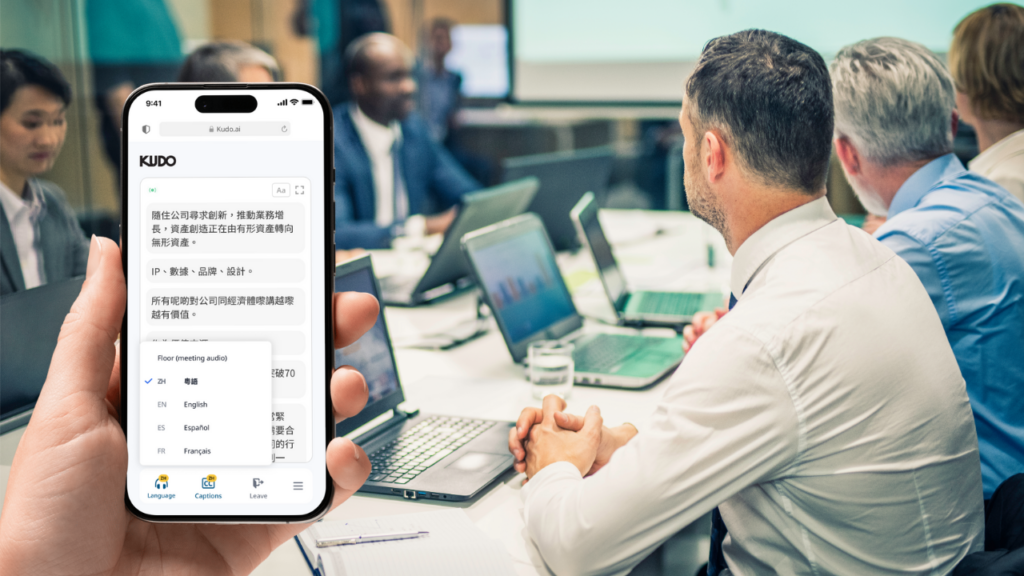When global teams come together for corporate training, language can be one of the biggest barriers to learning. Even the most insightful presentation loses impact when participants struggle to follow along in real time. That’s why organizations have long relied on human interpreters to make training and learning and development programs accessible across languages.
But interpretation alone, while essential, doesn’t always solve the full comprehension challenge. In a hybrid, fast-paced learning environment, employees need multiple ways to process and retain information. That’s where AI-powered live captions come in.
Recent research confirms that combining human interpretation with AI-generated captions can dramatically improve comprehension, reduce cognitive strain, and create a more productive learning experience for everyone. Let’s explore why this “dual-modality” approach is emerging as the gold standard for inclusive corporate learning, and how KUDO is leading the way.

The Problem: Learning in a Second Language is Hard Work
Picture this: a new global compliance training session is rolling out. The instructor speaks English, but half the audience is joining from offices in Tokyo, São Paulo, and Paris. KUDO’s professional interpreters are there, providing remote simultaneous interpretation. The participants can hear the message in their native languages, but they’re still processing dense terminology, complex examples, and fast-moving visuals.
Even with expert interpretation, following spoken language alone can be mentally taxing. When people are trying to listen, translate mentally, and understand new information at the same time, their cognitive load skyrockets. That can lead to fatigue, missed details, and lower information retention.
For learners, especially in technical or compliance-heavy subjects, a little extra support—like real-time captions—can make all the difference.
The Research: Why Two Channels Are Better Than One
A 2025 peer-reviewed study published in PLOS One by researchers at The Hong Kong Polytechnic University examined exactly this question. The study, titled “Simultaneous Interpreting with Auto-Subtitling: Investigating Viewer Cognitive Effort, Stress, and Comprehension,” compared three types of multilingual delivery:
- AI subtitles (captions) only
- Human simultaneous interpretation only
- A combination of both
Participants watched the same presentation in a foreign language while researchers measured their comprehension and cognitive effort using EEG brainwave analysis.
Here’s what they found:
- The dual-modality group (captions + interpretation) showed the lowest cognitive effort and stress levels.
- Their comprehension scores were the highest overall (even if not statistically significant).
- Participants also reported the best viewing experience, feeling more relaxed and engaged.
In contrast, participants who relied on captions alone reported higher stress, while those with audio-only interpretation showed greater mental effort.
The takeaway: when learners can both hear and read content in real time, they process information more efficiently and remember it better.
Why It Works: The Science of Dual Processing
This dual-modality advantage is backed by decades of cognitive research. According to the Cognitive Theory of Multimedia Learning, our brains have two main channels for processing information: auditory and visual. When both are activated in a complementary way, comprehension and memory retention improve dramatically.
Human interpretation delivers emotional nuance and natural speech cues, while AI-powered captions provide visual reinforcement and clarity, especially for complex terms or unfamiliar accents. When used together, the two systems share the cognitive load, reducing fatigue and helping learners stay focused longer.
In other words, dual-modality doesn’t overwhelm the brain—it actually gives it more ways to succeed.

The KUDO Advantage: Combining AI and Human Expertise
At KUDO, we’ve built our meeting and event platform around this exact principle: combining human intelligence and AI efficiency to create the most inclusive and effective multilingual experiences possible.
Here’s how KUDO makes it happen in corporate training sessions:
1. Human Interpretation: Real Expertise, Real Connection
KUDO connects you with professional language interpreters fluent in over 200 spoken and sign languages. They don’t just translate words, they convey tone, emotion, and cultural nuance that keep learners engaged.
2. AI-Powered Live Captions: Instant Visual Support
Our AI captioning engine provides real-time transcription and translation in multiple languages. Captions appear as learners listen, reinforcing understanding and helping participants follow along—even if they briefly lose track of the spoken interpretation.
3. Seamless Integration with Training Platforms
KUDO integrates with popular online meeting platforms like Zoom, Microsoft Teams, and LMS platforms. That means trainers and learners get a unified experience—voice, text, and visuals perfectly synchronized.
The Impact on Learning: What It Means for Your Teams
Adding AI captions to interpreted training sessions has measurable benefits:
- Better Comprehension and Retention
Learners absorb more information when they can hear and read simultaneously. Captions act as a cognitive anchor, helping people retain key points and technical terms. - Reduced Cognitive Load and Stress
By distributing information across both audio and visual channels, dual-modality access helps prevent mental fatigue—especially in long or complex training sessions. - Improved Accessibility and Inclusion
Live captions ensure that deaf or hard-of-hearing participants, as well as non-native listeners, can fully participate. It’s a simple way to meet DEI and accessibility goals while fostering equity in learning. - Higher Engagement
When learners can follow at their own pace and confirm understanding visually, engagement increases. They feel more confident, more in control, and more connected to the session. - Scalability and Cost Efficiency
AI captions scale instantly across regions, while human interpreters ensure quality and nuance. The result? A flexible, future-ready model for global learning delivery.
Where It Matters Most
Dual-modality support with KUDO is especially valuable for:
- Compliance and regulatory training, where accuracy and terminology are critical
- Technical or product education, where learners benefit from reading complex data or instructions
- Leadership and culture programs, where emotional tone and nuance enhance understanding
- Global onboarding, ensuring every new employee receives the same high-quality training experience
Whether it’s a live seminar, virtual workshop, or hybrid session, adding captions to interpretation ensures every learner, in every language, can fully participate.
The Future of Inclusive Training
As AI technology continues to advance, the combination of AI captions and human interpretation isn’t just a nice-to-have—it’s becoming a new standard for inclusive corporate communication. The research is clear: this hybrid approach not only supports accessibility but also enhances how people process and retain information.
KUDO’s mission is to make multilingual communication effortless for everyone. By integrating AI-powered captions with professional interpreters, we’re helping global organizations deliver learning experiences that are not only accessible, but truly effective.